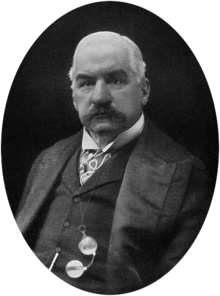
Back J.P. Morgan Afrikaans جون بيربونت مورجان Arabic جون بيربونت مورجان ARZ J. P. Morgan AST Con Pirpont Morqan Azerbaijani Морган Джон Пирпонт Bashkir Джон Пірпант Морган Byelorussian Джон Пирпонт Морган Bulgarian J. P. Morgan Bislama জে. পি. মরগান Bengali/Bangla
John Pierpont Morgan (April 17, 1837 – March 31, 1913)[1] was an American financier and investment banker who dominated corporate finance on Wall Street throughout the Gilded Age and Progressive Era. As the head of the banking firm that ultimately became known as J.P. Morgan and Co., he was a driving personal force behind the wave of industrial consolidations in the United States at the turn of the twentieth century.
Over the course of his career on Wall Street, Morgan spearheaded the formation of several prominent multinational corporations including U.S. Steel, International Harvester, and General Electric. He and his partners also held controlling interests in numerous other American businesses including Aetna, Western Union, the Pullman Car Company, and 21 railroads.[2] Through his holdings, Morgan exercised enormous influence over capital markets in the United States. During the Panic of 1907, he organized a coalition of financiers that saved the American monetary system from collapse.
As the Progressive Era's leading financier, Morgan's dedication to efficiency and modernization helped transform the shape of the American economy.[1] Adrian Wooldridge characterized Morgan as America's "greatest banker".[3] Morgan died in Rome, Italy, in his sleep in 1913 at the age of 75, leaving his fortune and business to his son, John Pierpont Morgan Jr. Biographer Ron Chernow estimated his fortune at $80 million (equivalent to $2.5 billion in 2023).[4]
- ^ a b "J.P. Morgan". Encyclopædia Britannica. Retrieved April 17, 2020.
- ^ Ward, Geoffrey C.; Burns, Ken (2014). The Roosevelts: An Intimate History. Alfred A. Knopf. p. 78. ISBN 978-0-307-70023-0.
- ^ Adrian Wooldridge (September 15, 2016). "The alphabet of success". The Economist. Retrieved September 16, 2016.
- ^ "John Pierpont Morgan and the American Corporation". Biography of America. Archived from the original on May 22, 2019. Retrieved May 11, 2018.
© MMXXIII Rich X Search. We shall prevail. All rights reserved. Rich X Search
